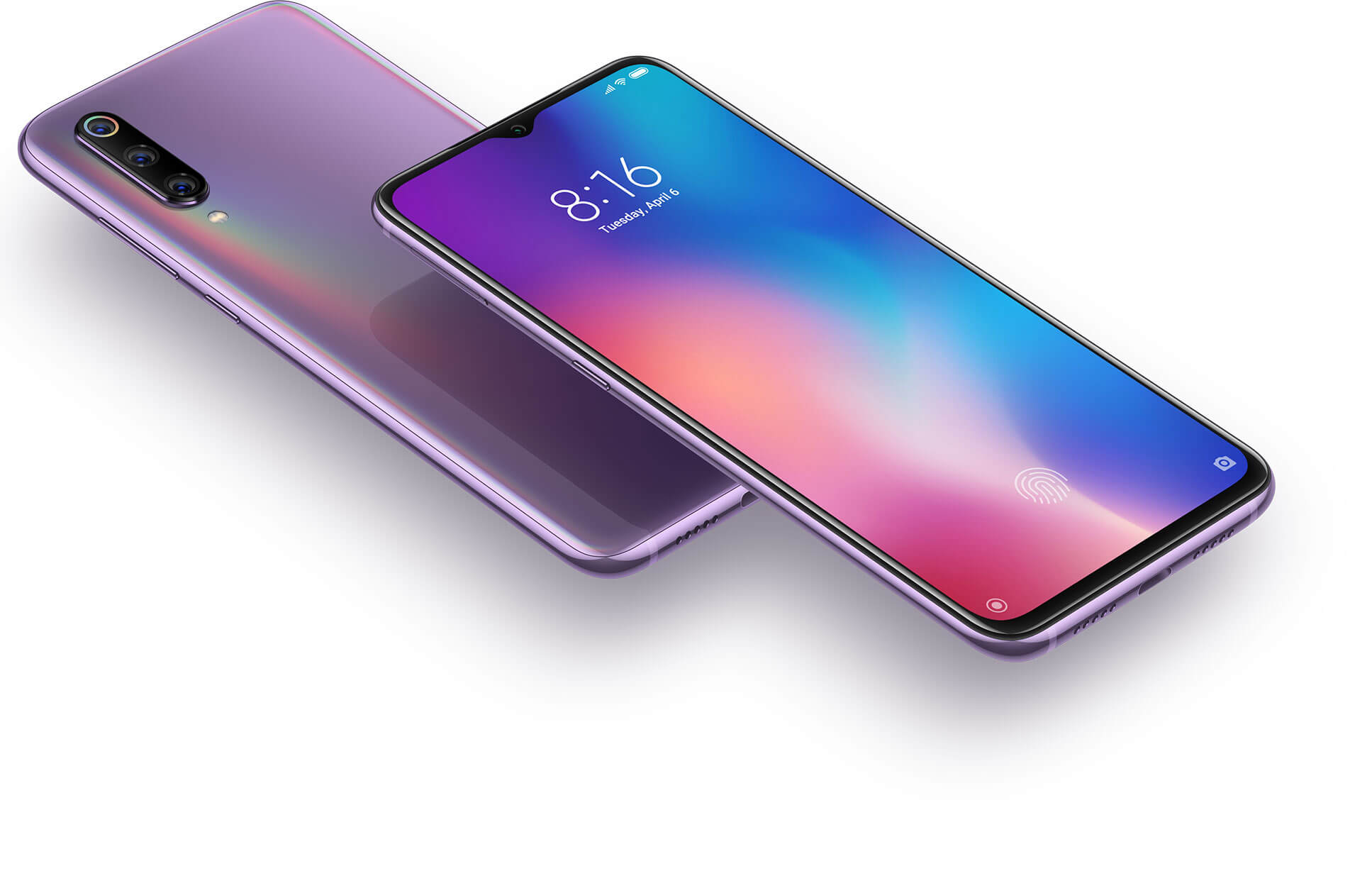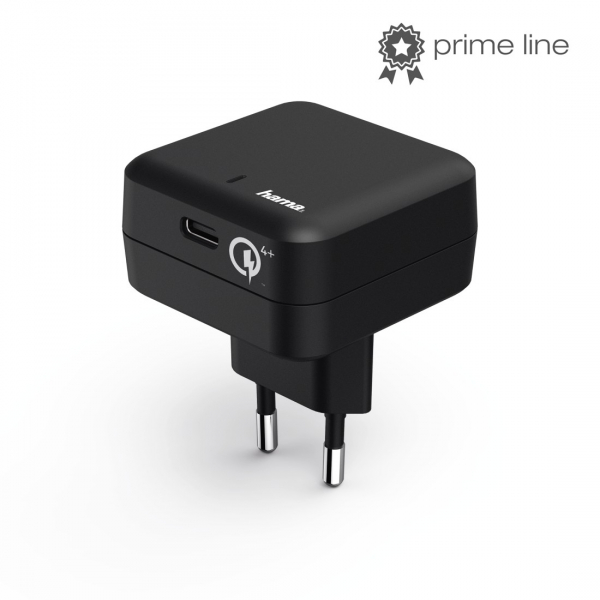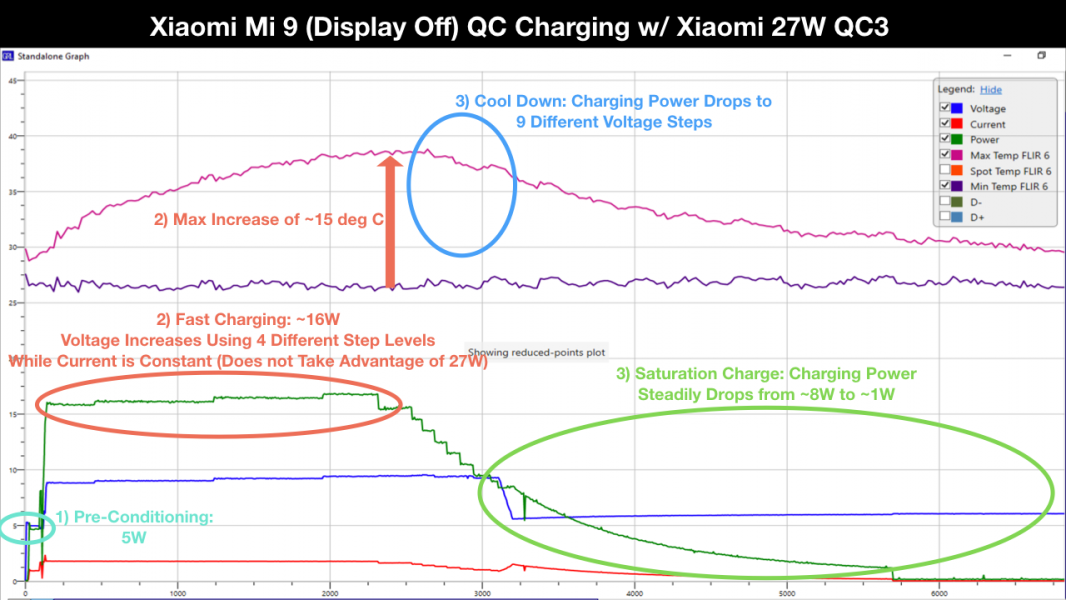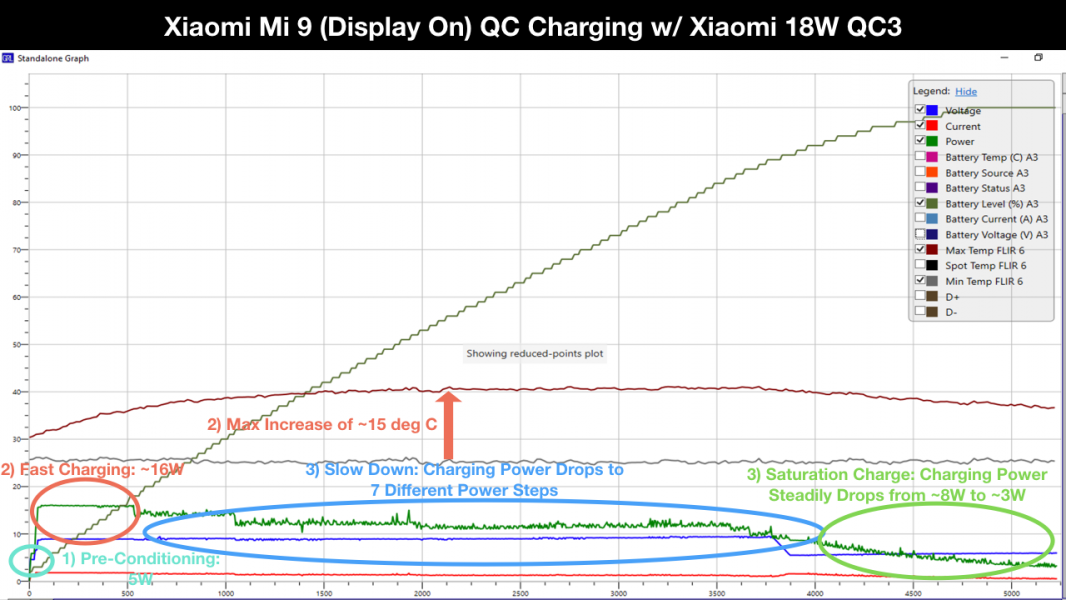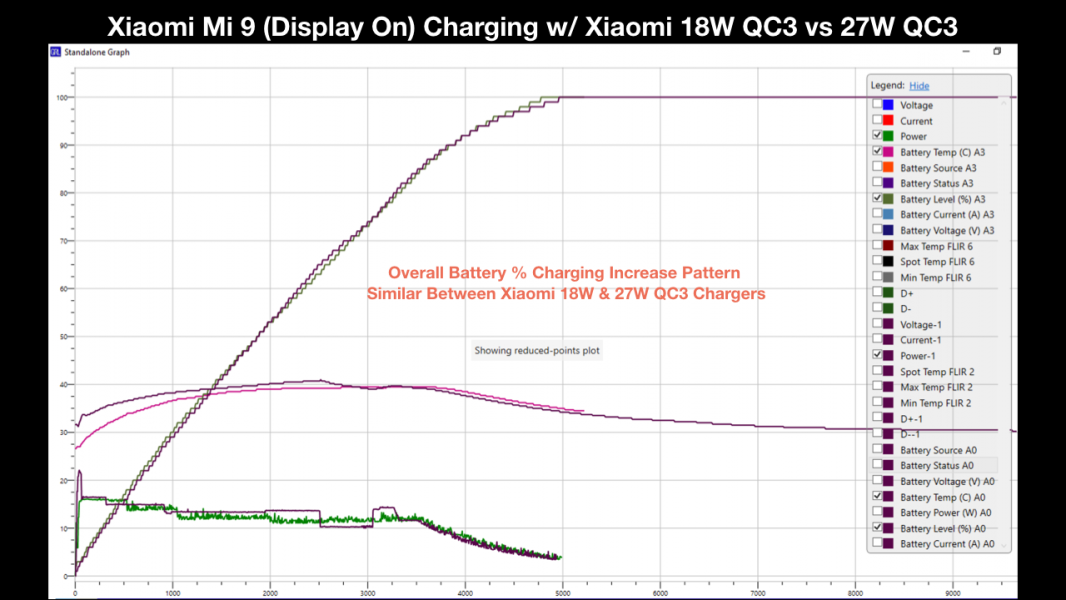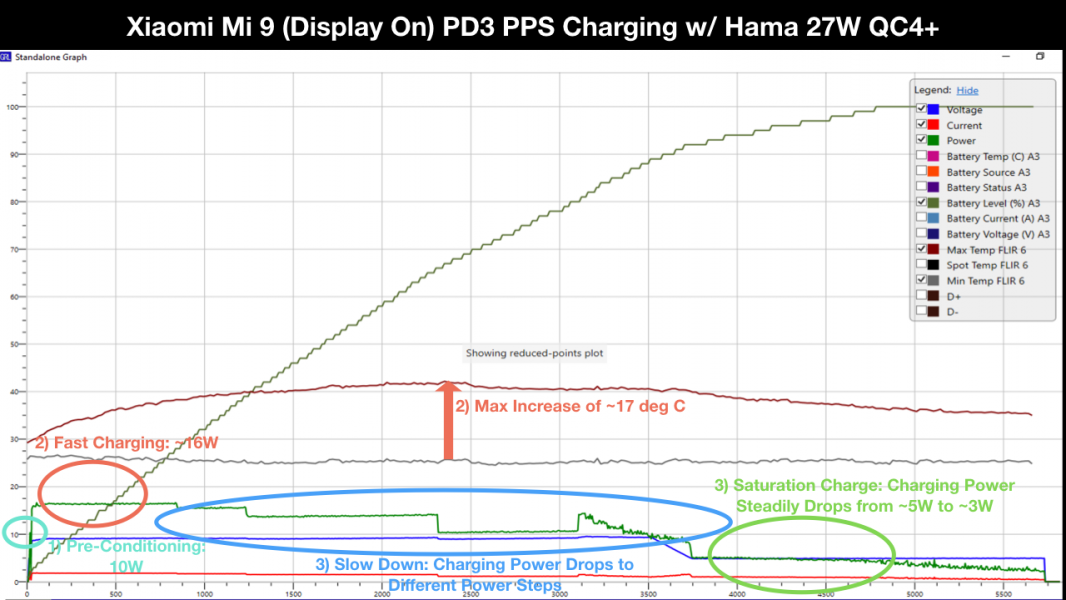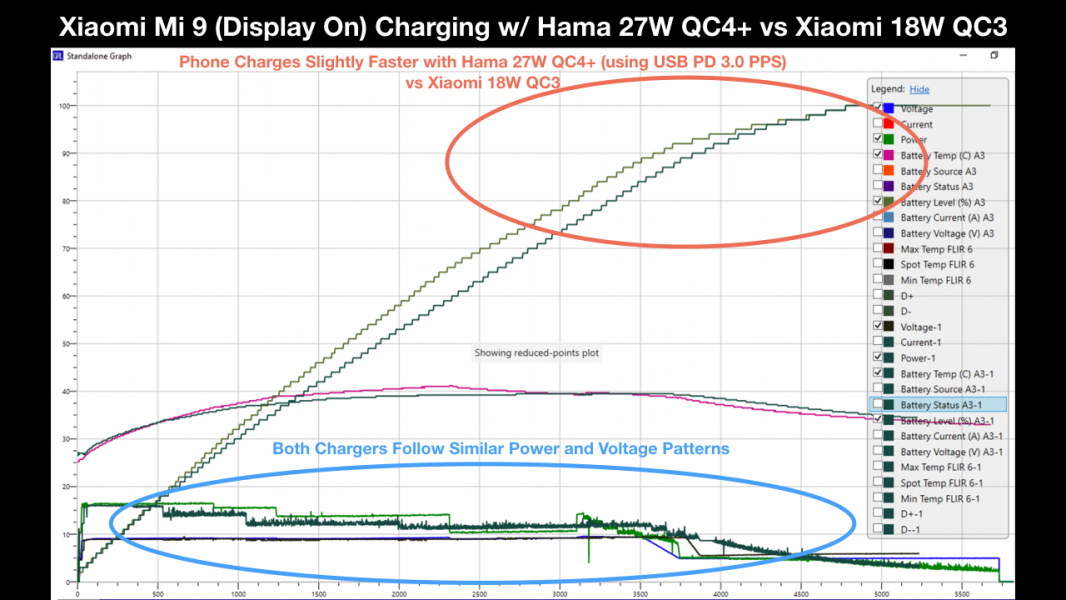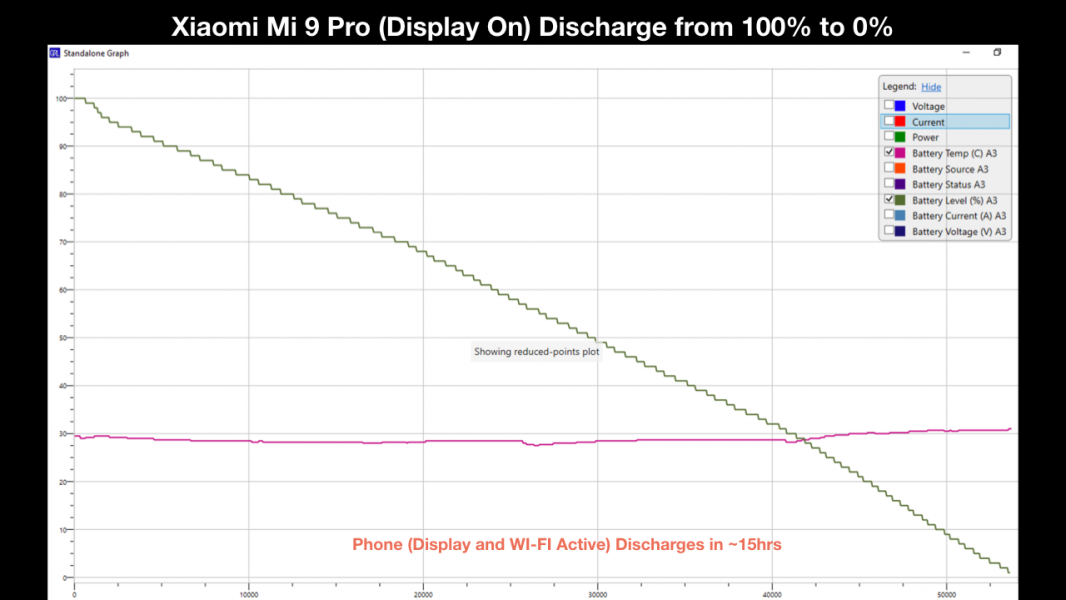Let's take a closer look at how the Xiaomi Mi 9 charges with the Xiaomi 27W QC3 charger, Mi 18W QC 3.0 Charger and Hama 27W QC4+ Charger.
Unlike the Xiaomi Mi 9 Pro 5G charges with the Xiaomi 45W QC3 charger's USB Type-A port using USB Power Delivery 3.0 based PPS technology, the Mi 9 charges with the Xiaomi 27W QC3 charger using just standard Quick Charge technology. Note the Xiaomi 27W QC3 charger was shipped in-box with the phone.
We use the GRL-C2 USB PD Tester and GRL-PSP Power Analyzer software from Granite River Labs to analyze the details on how the Mi 9 works with the Xiaomi 27W QC3 charger.
When the Mi 9 is fully drained and kept off, we connect the phone to the Xiaomi 27W QC3 charger. In the "Pre-Conditioning" mode, VBUS power started off at 5W for a brief period of time. During the “Fast Charge” mode, VBUS power mostly stays around 16W while VBUS voltage increases gradually in four different step levels while current stays constant. In this mode the phone's external temperature (which is recorded using a FLIR camera) increases by 15° C with the phone not taking advantage of max 27W charging with the charger. During the “Cool Down” mode, we see that power drops to multiple power levels at nine different VBUS voltage steps. Finally, in the “Saturation” mode, the VBUS voltage stays constant while current gradually gets lowered (the phone is consuming about 8W dropping down to 1W) until the phone’s battery is 100% full.
We now repeat the same testing and analysis, but this time with the Mi 9 drained to 2% and with the display and WI-FI kept active. Here, we see that during the “Fast Charge” mode, VBUS power reaches around 22W for a very short period of time before going into a “Cool Down” mode where power drops to multiple power levels at different voltage steps with max increase of temperature to 15° C. "Saturation" mode starts when the battery charge hits close to 90%. We can also see that VBUS power steadily drops as the battery reaches 100% charge, with the display and WI-FI kept active.
Comparing how the Mi 9 charges when the phone is off versus when the display and WI-FI are kept active, we can see that while the phone's display and WI-FI are kept active, the phone charges with more power initially and achieves 100% charging at almost similar times as when the phone is off- about 1.5 hours with display and WI-FI kept active versus around 1.6 hours when off.
Now let's see if the Mi 9 actually charges faster with the Mi 18W QC 3.0 Charger versus the Xiaomi 27W QC3 charger, with the phone's display and WI-FI kept active.
We connect the Mi 9 to the Mi 18W QC 3.0 Charger with the phone drained to 2% and the display and WI-FI kept active. Here, we see that in the "Pre-Conditioning" mode, VBUS power started off at 5W for a very brief period of time. During the “Fast Charge” mode, VBUS power stays at about 16W with max increase of temperature to 15° C. When going into a “Cool Down” mode, power drops to seven different power step levels. "Saturation" mode starts when the battery charge hits 90% where the VBUS power steadily drops from about 8W down to about 3W as the battery reaches 100% charge, with the display and WI-FI kept active.
Comparing how the Mi 9 charges with the Mi 18W QC 3.0 Charger versus the Xiaomi 27W QC3 charger, when the phone's display and WI-FI are kept active, we can see an overall similar pattern for battery % charging increase between the Mi 18W QC 3.0 Charger and the Xiaomi 27W QC3 charger.
Now we look at how the Mi 9 charges with the Hama 27W QC4+ Charger using USB Power Delivery (PD) 3.0 PPS, with the phone's display and WI-FI kept active.
When connecting the Mi 9 to the Hama 27W QC4+ Charger with the phone drained to 2% and the display and WI-FI kept active, we can see that in the "Pre-Conditioning" mode, VBUS power briefly started off at 10W. During the “Fast Charge” mode, VBUS power stays at about 16W with max increase of temperature to 17° C. When going into a “Cool Down” mode, power drops to multiple power step levels before entering "Saturation" mode. When the battery charge hits around 90%, "Saturation" mode starts where the VBUS power steadily drops from about 5W down to about 3W until the phone’s battery is 100% full, with the display and WI-FI kept active.
Comparing how the Mi 9 charges with the Hama 27W QC4+ Charger versus the Mi 18W QC 3.0 Charger, with the phone's display and WI-FI kept active, we can see that the Hama 27W QC4+ Charger charges and achieves 100% charging slightly faster using USB PD 3.0 PPS versus the Mi 18W QC 3.0 Charger using Qualcomm Quick Charge 3.0. We also see that overall both the Hama 27W QC4+ Charger and the Mi 18W QC 3.0 Charger follow similar patterns for power and voltage.
Here we can see the Mi 9's discharging behavior where 100% to 0% battery discharge is achieved in ~15 hours when the phone's display and WI-FI are kept active.
 GTrusted
GTrusted

